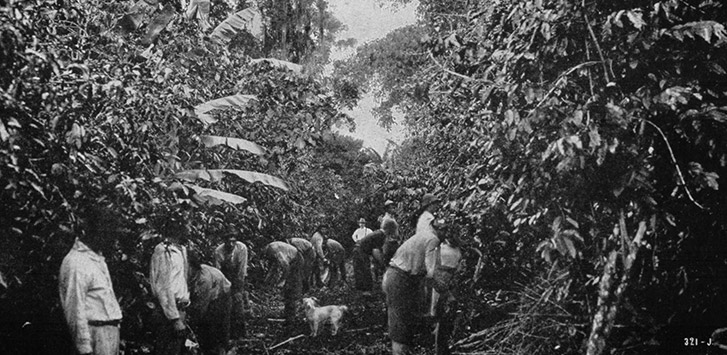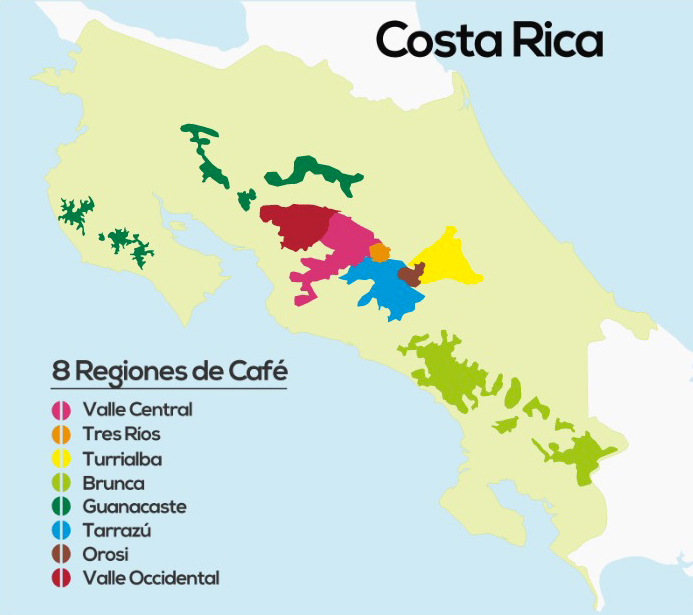
Costa Rica is world-renowned for producing some of the best coffee beans in the world. Not only a jewel in Central America but of the world, Costa Rica is blessed with an almost perfect temperate climate that is enriched with volcanic soil creates almost "Garden of Eden-like" conditions for coffee growing.
Its coffees often ranking right up alongside top coffee contenders like Ethiopians, Kenyans, Jamaicans, and Hawaiians. Known for its bright acidity that packs tons of chocolate and fruity note while having a lighter body than most, if you have not tried our curated selection of Costa Rican coffee beans yet, you are missing out!
History of Costa Rican Coffee

The relationship between the simple coffee plant and the country of Costa Rica is an intimate one. With the coffee beans being introduced in 1779. Soon after the collapse of the Spanish Empire's rule in 1821, the newly formed government spurned the development of the crop by given "free land" to coffee farmers to scale up production. While this land grab did lead to the development of large-scale coffee barons who owned large plantations, most coffee producers in the country have always been small-scale farmers.
This ramp-up in coffee production and eventual exportation allowed for financing the growth and development of the new country. Only a full eight years after independence, in 1829, revenue from Costa Rican coffee exports surpassed other exports from the country such as sugar, tobacco, and cacao.
By 1832, Costa Rica and the United Kingdom began a lengthy trade partnership in which the UK was nearly the primary consumer of coffee exports from the country (nearly up until World War 2!) The continued healthy trade led to further internal modernization projects across Costa Rica; from the first railroads to its National Theater being the biggest examples.
However, the country's over-reliance on the coffee bean hasn't been without problems and setbacks. Shortly after the end of WW2, in 1955, an export tax was imposed on Costa Rican coffee. Today the tax is levied at 1.5%. Additionally, 1983 saw a major coffee blight coincided with the collapse of the ICA, the International Coffee Organization, which resulted in world coffee prices dive-bombing by 40% throwing the Costa Rican coffee industry into crisis.
Throughout the 1980s and 1990s, coffee production and its associated prices would rise and fall. However, in 1989, Costa Rica joined other neighboring countries of El Salvador, Honduras, Guatemala, and Nicaragua to create a consortium that exported their coffee beans in batches to ensure price stability for the larger market after years of overproduction and exporting leading to price fluctuations.
Flavor Profile
Costa Rican coffees tend to be arabica beans and are generally praised for their upfront brightness, making them super flavorful. Additionally, most Costa Ricans tend to have notes of chocolate, stone fruits such as apricot, honey, orange citrus, molasses, and more. These flavor notes change depending on the coffee growing region, but one can reasonably expect one or more of the above. Finally, most Costa Rican coffees tend to have a light to medium body once brewed.
Growing Regions

Costa Rica is naturally blessed with an almost perfect climate to grow coffee. From its rich, volcanic soil providing tons of required nutrients, to the country's stable, warm climate with predictable dry and wet seasons, it is no surprise that Costa Rican coffee is often characterized as some of the best in the world.
Within the country, there a total of 8 recognized growing regions can be found in the central, mountainous, and high-altitude areas. The coffee beans that are grown in this mountain range are grown between 600 to 1,700 meters and unsurprisingly most Costa Rican beans are characterized as SHG, or "strictly high grown". Let's delve a bit more into each region to uncover the subtle differences of this treasured coffee.
Central Valley (Valle Central)
Unsurprisingly this region lies in the center of the eight growing regions, Valle Central almost compromises 15% of the total coffee grown in Costa Rica. The growing altitudes of this region are between 1k to 1.2k meters above sea level in volcanic soils. This unique microclimate of the Valle Central creates coffee beans that have a profile that has rich tasting notes of fruit and chocolate with a pleasant honey aroma.
Tres Rios
Laying along the slopes of Irazu Volcano and just a few miles outside the nation's capital, San Jose, Tres Rios coffee is perhaps the best-known coffee bean varietal to come from Costa Rica. This growing region is the smallest of all the regions and farms can be found up to 1,650 meters above sea level.
These coffees are known to deep and rich with a pronounced brightness that is full of notes such as honey, stone fruits like apricot, and oranges. We are lucky enough to have such a gourmet bean in stock, the Tres Rios Magnolia. Try this world-class coffee yourself and let us know what you think!
Brunca
The southern-most growing region, Brunca, produces nearly 20% of Costa Rica's coffee. The region also has a lot of variety in terms of growing altitudes which range from 800 to 1,700 meters above sea level. Generally, the beans that come from this area are a bit milder than in other regions. However, all beans from Brunca have intricate cupping notes of various citrus fruits.
Turrialba
This growing region is named after the volcano that is within this region, Turrialba sees the most rainfall out of all eight, which allows for several harvests throughout the year. Most beans here at grown around 1,400 meters high. Coffee beans that are harvested here can be characterized by their overall "softer profile" – with a light body, subtle aromas, and a mild acidity.
Guanacaste
This mountainous growing region is home to many small farmers and producers rather than large estates and plantations that can be found elsewhere. This region is also a bit warmer than others, especially during the summer. To protect their coffee plants from the heat, most farmers end up growing up in the mountains and under the shade of the mountain forests. Beans harvest from this area are very well balanced between aroma, body, and acidity making these a fine, if underrepresented, coffee to try out.
Tarrazu
Coffees coming from this growing region are said to be the cream of the crop, so to speak. This region producing gourmet varieties that are often considered the best in the country, if not the world depending on who you ask. Coffees coming from this region possess excellent flavor profiles that include notes of vanilla, fruits, chocolate, caramel, and more in super bright upfront cups with a heavy body.
We at Coffee Bean Corral are lucky enough to have two different Tarrazus in stock, the La Minita RFA which in our opinion is the smoothest, most well-balanced coffee we have, and the El Conquistador Tarrazu which offers the full range of what Tarrazu coffees offer.
Orosi
The Orosi growing region is one of the oldest coffee-growing areas in the country, dating back nearly 100 years, and sees a bit more rainfall than other growing regions. Most coffee sourced from here is growing along the slopes of Orosi mountains between 1,000 to 1,400 meters above sea level. Due to the great climate of the area, coffees from here are nicely balanced and smooth that do well being brewed in espresso-like drinks.
West Valley (Valle Occidental)
The westernmost growing region in Costa Rica, Valle Occidental, produces around 25% of the country's total coffee. While bordering the Tarrazu region, coffees are growing a bit lower than Tarrazus between 1,200 and 1,700 meters above sea level. Additionally, this region sees more of harvest being natural and honey processed compared to the wet processing that most Costa Rican beans go through. Expect notes of honey and chocolate with the honey processed lots, while you can expect stonefruits like apricot, peach, and even plum in naturally processed lots.
Cultivation & Well-Known Coffee Estates

Most of Costa Rican coffee is split between large plantations and estates or small farmers. Harvesting and cultivation tend to occur during the dry season (anywhere from June to March depending on the growing region).
At least within Costa Rica, most beans are wet-processed. Since the 1990s, wet processing has come under fire, as the thick slime made during the milling and de-pulping stages would be dumped into the rivers. This slime and pulp would then deplete the water of oxygen thereby harming and killing the aquatic life of the rivers.
On top of the illegal dumping, another major environmental concern that's impacting the Costa Rican coffee industry is the deforestation that occurred during the growth of the coffee industry in the 1800s and the subsequent soil erosion that this has caused across the fragile mountain forest ecosystems that compromise the growing regions.
Well Known Coffee Estates
Due to how the Costa Rican government encouraged coffee growing in the 1800s, large estates and plantations emerged alongside small farm holders in tandem and this dichotomy has continued in the country's coffee industry to this day.
The latest newcomer who has made a big splash in the industry since the 1990s is Hacienda La Minita. Cultivating a name for their exacting standards of growing, supporting their farmers, and cupping every single shipment, La Minita's name has become almost synonymous with Costa Rican coffee, especially beans coming from the Tarrazu region and they have become perhaps one of the most environmentally and socially conscious coffee operations in recent years.
If their conscious business practices and standards of quality interest you, you can find not only our Costa Rican beans from them but our other La Minita offerings with our handy blog post on them.
Roasting & Brewing Suggestions
Depending on your roasting preferences, most Costa Rican beans take to both light roasts or medium roasts quite well, as it brings to the forefront the bean's brightness. Whereas dark roasting your Costa Rican beans tends to subdue the brightness and add a subtle nuance to the overall bean.
Depending on which brewing method you prefer will determine where you should roast at, we suggest a pour-over for lighter roasts, whereas if you like your beans at a medium to dark roast, a French press is the way to go. However, you can still drip brew coffee beans at a medium roast.
Hopefully, this guide has helped illuminate just how varied Costa Rican coffee beans are; from their importance to the country's history and development to how the large estates and hand-picked, high quality beans that have become known and prized the world over for their brightness, gourmet flavor profile, and approach to environmental concerns. Try out some of our selections today!